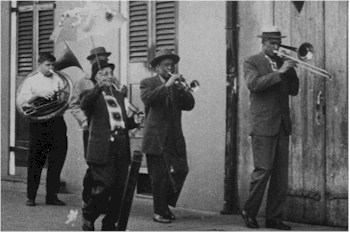
Preservation Hall Jazz Band marching in the New Orleans French Quarter. Photo © William Carter.
This week on Riverwalk Jazz Jim Cullum and the Band present a concert of traditional jazz favorites we call The Bourbon Street Top Ten.
Musicians and fans both affectionately refer to these standard tunes as "war horses" or "old chestnuts" because they’ve been played and recorded many times by jazz bands for over a century. Muggsy Spanier, Eddie Condon, Lu Watters, Turk Murphy and Louis Armstrong have all made famous recordings of these pieces. Today these tunes are the best-loved and most-often-requested pieces by classic jazz fans. Louis Armstrong often introduced them in his live concerts as "the good ol' good ones."
Joining Jim and the Band this week is a very special guest cornetist from Sydney, Australia—Bob Barnard. One critic called Barnard one of the “cleanest and most cliché-free cornet players” in the world. He’s a headliner and star soloist at jazz festivals worldwide and a great friend of the Band.
.jpg)
Cornetist Bob Barnard. Photo courtesy of the artist.
Here are some of the familiar tunes featured on our program this week and how they became so famous:
"Muskrat Ramble" was written in 1926 by New Orleans trombonist Edward "Kid" Ory and recorded by Louis Armstrong's ground-breaking recording group known as the Hot 5.
"St. James Infirmary Blues" is a traditional American folk song, the lyric of which can be traced to late 19th-century New Orleans. After a famous 1928 recording by Louis Armstrong, Cab Calloway and His Orchestra recorded it for a 1933 Betty Boop cartoon "Snow White" that is still seen by millions of children on television and considered a classic of early cartoon animation. In the "St. James Infirmary" sequence Cab's dance moves were transferred from live-action film to animation by a process called the "roto-scope."
"Tiger Rag" is another old folk tune from New Orleans whose provenance is shrouded in mystery. Among those claiming authorship were the Original Dixieland Jazz Band, who had an early hit recording with it, and Jelly Roll Morton. The most famous recorded versions are by Armstrong and alto saxophonist Jimmy Dorsey.

"Sweet Georgia Brown" sheet music cover. Image courtesy songbook1.wordpress.
"Sweet Georgia Brown" was composed in 1925 by Ben Bernie, Maceo Pinkard and Kenneth Casey and went on to become #13 on the list of The 100 Most-Recorded Songs, 1890-1954. A famous whistling version has become associated with the Harlem Globetrotters.
"Dark Town Strutters Ball" dates from 1917 and was composed by Shelton Brooks, who also composed "Some of These Days." The 1917 version by the Original Dixieland Jazz Band of New Orleans was one of the first jazz records made.
"Just a Closer Walk With Thee" and "When the Saints Go Marching In" are both African-American spirituals that were long a part of the traditional New Orleans repertoire. The Jim Cullum Jazz Band performed these tunes in their Jazz Mass.
"Do You Know What it Means to Miss New Orleans" is the newest tune on our list, written by Louis Alter and Eddie DeLange for the 1947 motion picture New Orleans. In the film the tune is sung by Billie Holiday backed up by Louis Armstrong and his band.
"Basin Street Blues" was composed by Spencer Williams in 1928. Louis Armstrong recorded it shortly thereafter with Earl Hines. The famous verse with the lyric "Won't you come along with me..." was added later by Glenn Miller. This version is today associated with the great Jack Teagarden.
Photo credit for Home Page: Preservation Hall Jazz Band marching in the New Orleans French Quarter. Photo: © William Carter.
Text based on Riverwalk Jazz script by Margaret Moos Pick ©2004

